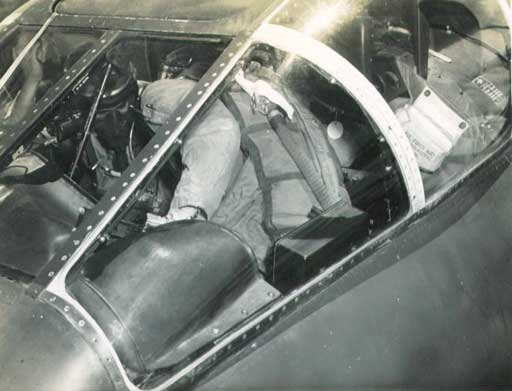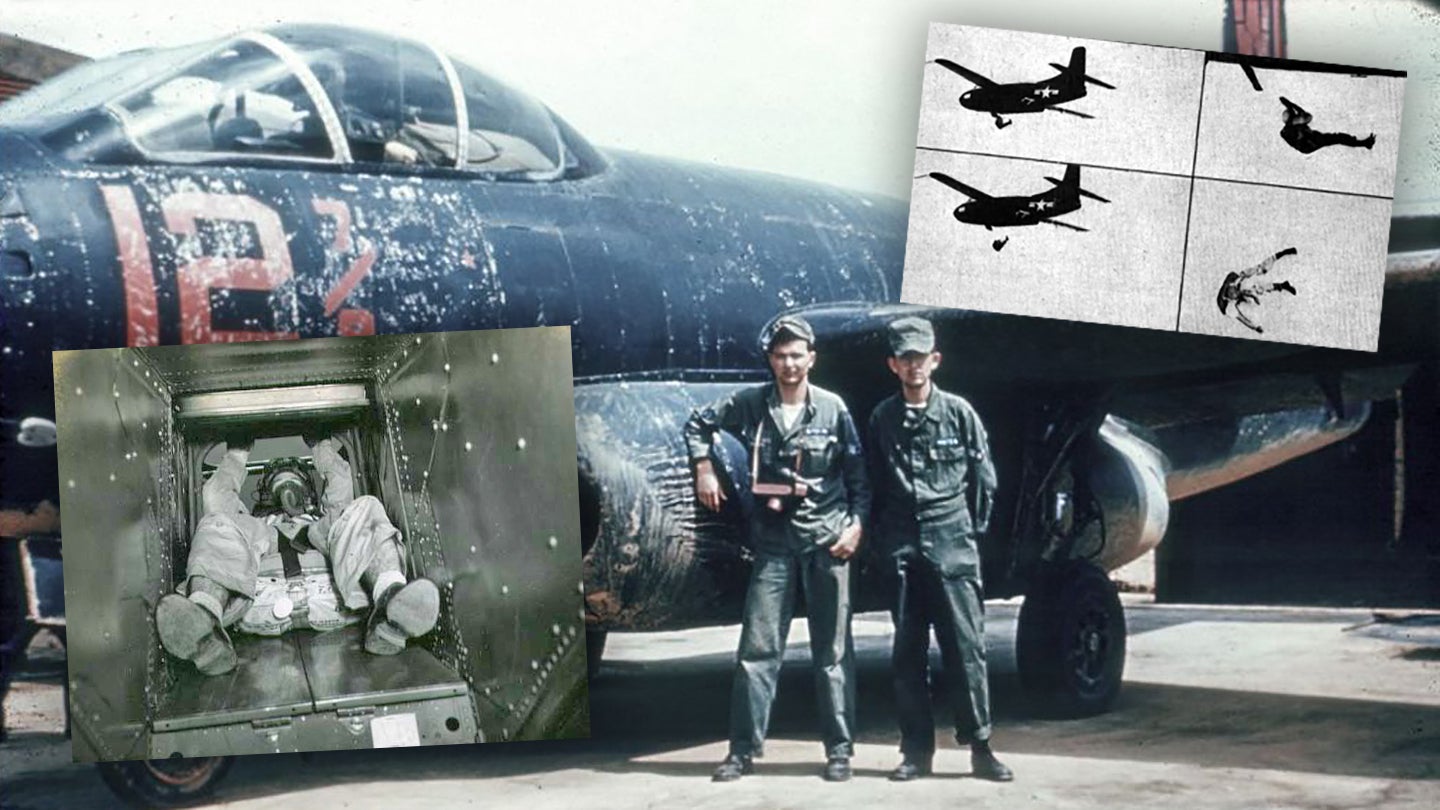The Douglas F3D Skyknight was an early carrier-capable jet fighter that first saw combat in the Korean War, and again over Vietnam. Unusually, in case of a serious emergency, its crew were expected to bail out via an escape chute, rather than using more familiar ejection seats. This unusual procedure was even adapted to deliver special operations forces on at least one occasion during maneuvers in the late 1950s.
While rather forgotten today, the Skyknight represented a major advance for the U.S. Navy and Marine Corps when it arrived in service in 1950. Big and bulky, the Douglas design, armed with four 20mm cannons, had little in common with the sleek jets that were by then starting to appear. Still, over Korea it established an enviable record as a night-fighter, achieving the world’s first night-time jet-versus-jet kill using radar and becoming the highest-scoring Navy and Marine Corps fighter of that conflict.

The fact it was developed as a night-fighter goes some way to explain why the designers chose this unorthodox crew escape system. The squat, straight-winged Skyknight was built around a two-crew concept, with a pilot plus an airborne intercept operator (AIO), at least in the initial versions, to operate the separate search and tracking radars in the nose. Since this was the era of vacuum-tube technology, a wide fuselage was required to accommodate this equipment, which could detect targets at a range of between 15 and 20 miles. There was another radar in the tail to scan for hostile aircraft approaching from the rear.

Side-by-side seating was better for crew coordination and the ejection seats then available were not considered safe enough to extract two people sitting next to each other, due to the danger of collision or damage from the respective rocket motors. In addition, the rocket-powered seats would have added more weight and complexity to a design, which was powered by two non-afterburning Westinghouse turbojets that were already somewhat lacking in thrust.
Instead, a tunnel-like chute led down and aft from the cockpit, behind the seats, from which the crew could slide down in an emergency, popping out from the underside of the jet, between the engines. This system was also supposed to be safe to use at high speeds. A similar arrangement would later be a feature of the Douglas A3D Skywarrior, although that was a Cold War bomber design, so a lack of ejection seats was less unusual.

Exactly how the crew would exit the stricken Skyknight is explained by former U.S. Air Force F-15 Eagle pilot Paul Woodford on his blog, which you can check out here:
“In the event that the crew had to bail out, they would depressurize the cockpit and pivot their seats toward each other. The first crewmember [the AIO] would get out of his seat, face aft, and kick open the escape chute door, which would presumably fall out and away through the chute. Grasping a horizontal bar, the crewmember would swing into the chute feet first, then slide out the belly of the aircraft, followed by the second crewmember.”
The following sequence of photos shows ground tests of the F3D crew escape system:




This same method of practicing bailout was continued throughout the career of the F3D, which was redesignated F-10 from September 1962 when a new U.S. military-wide aircraft nomenclature system was adopted. Typically, the aircraft would be jacked up and mattresses would be laid out under the belly for this kind of training.
“When you get ready to go, there’s a handle that you pull, and a trap door flies open, and a panel on the bottom of the airplane falls off, and the pilot’s seat literally falls apart,” Marine General Jack Dailey told
Air & Space magazine. “We used to try to jump on the ECMO [electronic countermeasures officer, who replaced the AIO in later models],” Dailey added. “If he loitered on that mattress, he was going to get stomped on by the pilot.”

Despite being the recipient of several less than complimentary nicknames — “Willie the Whale,” “Turtle,” “Blue Whale,” “Drut” (the last of those intended to be read backward) — the Skyknight enjoyed a long career with the Navy and Marine Corps as a night-fighter, radar intercept trainer, and electronic jamming platform. The crew escape system does not seem to have been a particular problem and there are no recorded attempts to retrofit ejection seats, even during the jet’s final years of combat service in Vietnam.
Confidence in the escape system would have been provided, at least in part, by a series of live crew extractions made by experienced parachutists during tests at Naval Air Facility El Centro in California even before the F3D entered service. In these tests, parachutists successfully bailed out of the jet no fewer than 22 times at speeds of between 139 and 444 miles per hour.

Then, test dummies were substituted for live parachutists as the speeds were increased to 496 miles per hour. The top speed of the F3D was around 530 miles per hour. Again, these trials proved successful. For the crew, it was recommended to open the parachute between five and 20 seconds after bailing out, it being calculated that they would have decelerated in that time and the forces exerted on them when the canopy opened would be reduced accordingly. In other tests, the jet maneuvered as the parachutist bailed out, imparting forces of up to 3.5 G. Again, things went as planned.
Such was the versatility of the Skyknight that thought was also given to using its unusual crew-extraction system to deliver Marine reconnaissance troops via the same method.
Interviewed by Air & Space magazine, Marine Corps pilot Jerry Dixon recalled an exercise in the Philippines in early 1958 in which his F3D was slated to fly a mission as an adversary aircraft. To make things tougher for the defending forces, a flight of four Skyknights would each carry a Marine commando instead of an AIO, dropping them behind enemy lines in a clandestine night-time insertion.
“When we got to the drop zone, the formation leader made the prearranged signal to drop, I tapped my raider on the head, and he was gone like a shot,” recalled Dixon. “You talk about a set of balls to do what those guys did.” Two of the commandos suffered broken bones once they landed in the jungle.

The Skyknight’s insertion of special forces continued a tradition established in World War II, during which adapted bombers were typically used to deliver agents, again often via chutes. Similar tactics also continued after that conflict and the Marines, in particular, also trained to drop reconnaissance elements from the cargo compartments of their OV-10 Bronco aircraft.
The latter half of the Skyknight’s career was dominated by second-line roles, but many of these involved critical test work, including for advanced radars, missile guidance systems, and other electronic equipment. During the 1950s, adapted aircraft had the new Sparrow I beam-riding air-to-air missile integrated, helping prove out this emerging technology, while another F3D became the first aircraft to complete an automatic carrier landing, in 1957.
The Skyknight also provided radar training to fighter pilots destined to fly other, more advanced types, including radar intercept officers (RIOs) for the F4H-1H Phantom II, which was later redesignated the F-4B.

The very last frontline variant was the F3D-2Q — later redesignated the EF-10B — a radar-jamming aircraft that served with the Marine Corps at Da Nang, South Vietnam, from April 1965, flying passive and active electronic warfare missions over North Vietnam. The last such mission was flown in May 1970. Even after that date, F-10s continued to be used for various research and development work for decades, at least some technically being transferred to the Army and then operated by Raytheon contractors for this purpose.
All through this time, the crews of the Skyknight relied on a unique escape system, should they have ever got into serious trouble to the point of needing to make a hasty exit from the cockpit.
Contact the author: thomas@thedrive.com
